Flat stitch combines practical and aesthetic benefits: first, it holds fabric together by closing seams and hems; second, it highlights and enhances patterns in embroidery and quilting; and third, it secures appliqués, repairs, or darning. Variations of flat stitch include double flat stitch (stitching a solid line forward, then back) and lace flat stitch (stitching a second line between flat stitches). The flowing stitch is an essential element of hand sewing and many traditional embroidery styles around the world, from Indian Kantha embroidery to Japanese sashiko and American colonial embroidery. Its simplicity and versatility make it an essential foundational stitch in hand sewing, including Indian Kantha, Japanese sashiko, and American colonial embroidery.combines practical and aesthetic benefits: first, it holds fabric together by closing seams and hems; second, it highlights and enhances patterns in embroidery and quilting; and third, it secures appliqués, repairs, or darning. Variations of flat stitch include double flat stitch (stitching a solid line forward, then back) and lace flat stitch (stitching a second line between flat stitches). The flowing stitch is an essential element of hand sewing and many traditional embroidery styles around the world, from Indian Kantha embroidery to Japanese sashiko and American colonial embroidery. Its simplicity and versatility make it an essential foundational stitch in hand sewing, including Indian Kantha, Japanese sashiko, and American colonial embroidery.

Basting stitches are temporary long, loose stitches used to temporarily hold fabric layers together before final sewing. Basting stitches tend to be larger than regular stitches for easy removal and are frequently created using thread with different colors or easily removable thread types. They serve to temporarily hold fabric pieces together, replace pins when more stability is required, and help align fabric layers for accurate sewing. Common uses for temporary holding seams or hems before permanent stitching. Prior to beginning sewing, positioning appliques, trims and interfacing can help ensure proper sewing results. Gather fabric by placing rows of basting stitches and pulling on the thread to form gathers.

Permanent stitches include the following: Lockstitch (also known as running stitch): An elegant yet basic hand stitch used to create permanent seams that are both strong and easy to use. Backstitch: A very strong stitch pattern where stitches overlap to create a secure seam; it's ideal for durable seams in clothing. Lockstitch and Backstitch: Combines the speed of a lockstitch with the strength of a backstitch to create a stronger, longer-lasting seam. Hemming: Inconspicuous from the right side; neatly secures a hem from the wrong side of the fabric. Blocking: Covers a raw edge to prevent fraying; commonly used on buttonholes or appliqué edges. Overlocking: Used to prevent fraying without an overlocker, overlocking covers a raw edge to prevent wear. Pick stitch: A fine, nearly invisible stitch often used in tailoring to create delicate seams or attach welts. Pad stitch: A small stitch sewn perpendicular to a seam to enhance the firmness and shape of a garment and to strengthen lapels and collars. Permanent stitch securely joins fabrics together. The choice of permanent stitch depends on the fabric type, garment function, and durability. When choosing a permanent stitch design, use matching thread for optimal appearance and strength.
HONG KONG & BIAS BOUND SEAMS
This Hong Kong hemming technique uses a bias tape to wrap around the raw fabric edge, preventing fraying and creating a refined interior look. Unlike overlocking, bias tape is sewn onto the raw edge, then folded and sewn together, resulting in a durable, smooth finish. It's often used on high-end tailored, unlined, or delicate garments. Biust tape offers flexibility and reduces bulk. It's best suited for moderately straight seams; curved seams require more care. Bias tape can be matched or contrasted with the fabric color for a decorative effect. The seam is sewn right-side up, the seam pressed open, and the bias tape is sewn onto the raw edge, folded, pressed, and sewn together—often using a "ditch-stitch" technique for an invisible effect. Biust-stitched seams follow the same principle, wrapping the raw edge with bias tape, but depending on the method, the tape edge may be folded or left raw. Hong Kong-style seams and twill bound seams provide an elegant, thin, and durable edge finish, extending the life of the garment and preserving its interior appearance, especially when seams are visible or fabrics are fragile.

HAND OVERCAST SEAMS OR WHIPPED SEAMS
Hand overcast seams (also referred to as "whipped seams") is a hand-sewing technique commonly used to finish raw fabric edges and prevent fraying. The stitch wraps thread around fabric edge using small diagonal stitches resulting in an attractive, flexible, soft and tidy finish often found on couture or delicate garments. Key Points: Whilst passing from behind close to the raw edge, thread should be looped around smoothly without tightening too tightly and puckering up. Alternative to machine overlocking for lightweight applications. Ideal for delicate fabrics like silk, chiffon, lace and sheer materials. Though time consuming, this process produces an elegant, long-term interior finish. Can also serve as decorative stitching on applique edges. Hand threading requires matching single-thread, while pre-marked lines may help ensure uniformity of process.
SELF BOUND SEAM OR STANDING FLAT FELL
Self bound seams are quick, neat and ideal for lightweight to medium fabrics with straight or slightly curved seams that need finishing off quickly and neatly without extra fabric waste. A self bound seam resembles the French seam in terms of its folding action but without all its bulk. Standing flat-felled seams (flat-felled seams) create a strong, durable, and structured seam, often used in garments such as jeans and shirts. Pressing or positioning the seam gives additional shape or style.





 Hot News
Hot News